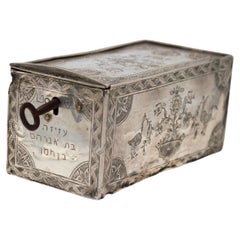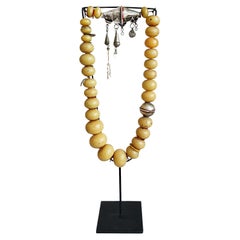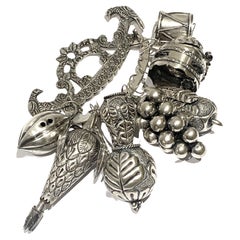Middle East - Tribal Art
to
742
527
2
1
1
2
2
1
1
1
1
1
1
2
2
2
Item Ships From: Middle East
extremely rare Algerian Judaica silver, jewish Dowry box early 19th century
Located in Tel Aviv - Jaffa, IL
Amazing and scarce JUDAICA object, we have here one of the most touching jewish objects we had for a long time, this small silver dowry box was made in Algeria in the early 19th century, it is all covered with symbols of jewish faith and of couples, the sliding lid has 2 flanking birds with hamsa (protective hand) on each side and a flower vase in the middle.
one side shows two flanking lions with a tree in the middle and the other side shows again two big and two small birds with a flower bowl in the middle, front side has a key hole and next to it there is the Hebrew inscription ס״ט״" which says Siman tov or in English "a good sign" it is taken from the wedding blessing, underneath the lock there is another inscription with the name ״עזיזה בת אברהם בן חמו״ which is the name of the bride, her father and her grandfathers name.
the box is full marked a lot of times with the silversmith mark, every side of the box is marked.
this box was probably ordered by the grooms family to hold the jewelry they are giving to the bride as dowry, this type of objects are rare and there are just a few of them on museum collections.
DOWRY (Heb. נְדֻנְיָה), the property a wife brings to her husband at marriage; the Yiddish equivalent, nadn, is from the same root. The custom of nedunyah became clearly defined and institutionalized only in the talmudic period. In biblical times, mohar (מֹהַר), whereby the groom bought his wife from her father (Gen. 24:53; Ex. 22:15–16; Hos. 3:2), was the accepted practice. It was then customary that the groom give the bride gifts, and that she bring certain property to her husband's home upon marriage: slaves, cattle, real estate, etc. (cf. Gen. 24:59–61; 29; Judg. 1:14ff.; I Kings 9:16). Evidence of the custom of nedunyah is to be found in Tobit (7:14; 8:21) and in the Assuan papyri (Cowley, Aramaic, nos. 15, 18). Gradually, mohar was superseded by the ketubbah custom according to which the husband merely assumed the responsibility of compensation to his wife in case he divorced her: he had to pay her 200 zuzim if she had been a virgin at the time of marriage, and 100 zuzim if a widow or divorcée (see *Ketubbah).
By talmudic times, the institution of nedunyah was prevalent; the father gave a dowry to the bride since the daughter was excluded from paternal inheritance. Fifty zuzim (equivalent to the worth of 180 grams of silver) was the minimum amount a father was obliged to give to his daughter (Ket. 6:5). Parents usually gave much more, according to their social standing. Community funds provided the dowry for an orphan or a very poor girl (ibid.; cf. Sh. Ar., YD 251:8). In case of her father's death, the brothers of a minor girl were obliged to give her the minimum dowry, and the court estimated how much her father would have given her above the minimum dowry. The sum was then taken out of the father's estate and given to the daughter upon majority (Ket. 6:6; 68a–69b). In the absence of such an estimate, each daughter was entitled to receive one-tenth of the value of her father's estate in money, or in valuables (Yad, Ishut, 20:4–7; Sh. Ar., EH 113:4). If the father was unable or unwilling to pay the promised dowry at the betrothal ceremony, the groom could refuse to marry his bride (Ket. 13:5; Ket. 108b–109a). Insistence on exact payment of the promised dowry, however, was frowned upon by later rabbinic authorities (Rema to Sh. Ar., EH 2:1). In certain communities it was customary for the groom's father to make a dowry contribution equal to that of the bride's father (Ket. 102b). The dowry, whether given in real estate, slaves, money, or chattel was recorded in the marriage contract (the ketubbah) and in some instances one-third or one-fifth of the actual value of the dowry was added to the sum mentioned in the ketubbah. Based upon a decree enacted by *Simeon b. Shetah (first century C.E.), the Talmud ruled that the husband and his entire property were liable for compensation as stipulated in the ketubbah, either in case he died (when she collected the sum specified in the ketubbah from the heirs) or in case he divorced his wife (Ket. 82b). For the status of the dowry and the husband's rights and obligations, see below. The rabbinic enactments (Takkanot Shum) by R. Jacob *Tam and by the rabbinic synod of the communities of Speyer, Worms, and Mainz (Germany) stipulated that if a woman died...
Category
Mid-19th Century Algerian Antique Middle East - Tribal Art
Materials
Silver
Important 18th century Persian Jewish silver Amulet for mother and newborn
Located in Tel Aviv - Jaffa, IL
Mysterious Amazing, 18th century silver talismanic amulet, Amulet for mother and Newborn with image of Lilith in the center made by Jews in Persia, the top of the Amulet has an amazi...
Category
1790s Antique Middle East - Tribal Art
Materials
Agate, Silver
Related Items
Berber Copal Amber and Silver Necklace, Early 20th Century
Located in New York, NY
A long Berber necklace, hand-crafted with Copal amber large beads and silver accents. Morocco, early 20th Century.
Copal amber is a tree resin similar to amber but not fully fossil...
Category
1920s Moroccan Tribal Vintage Middle East - Tribal Art
Materials
Silver
$520 Sale Price
20% Off
H 21 in W 4.75 in D 4 in
Rare Silver Balangandãs - 20th Century Brazilian Native Hanging Amulet
Located in Rio De Janeiro, BR
Mid 20th century brazilian silver hanging amulet from native culture in Brazil. Known as "Penca de Balangandãs" was used in the ancient times as an amul...
Category
Mid-20th Century Brazilian Other Middle East - Tribal Art
Materials
Sterling Silver
Antique Greek Pair of Silk/Metal Thread Embroideries, 18th Century
Located in San Francisco, CA
Antique Greek Pair Silk/Metal Thread Embroideries, 18th Century
Additional Information:
Dimensions: 0'11" L x 0'6" W
Origin: Greece
Period: 18th Cen...
Category
18th Century Greek Antique Middle East - Tribal Art
Materials
Metal
Antique hardwood carved Goddes statue from India, 18th century
Located in Bilzen, BE
An antique carved hardwood statue depicting a goddes with child on her arm
The statue has a very rich aged using patina and traces
This statue is dating from the 18th century but pro...
Category
18th Century Indian Tribal Antique Middle East - Tribal Art
Materials
Wood
Mid-20th Century Antoñio Pineda Silver and Moonstone Brooch, Taxco, Mexico
By Antoñio Pineda
Located in Point Richmond, CA
Mid-20th Century Antoñio Pineda (1919-2009) Silver and Moonstone Brooch, Taxco, Mexico
This beautifully crafted silver brooch contains eight oval-cut moonstone cabochons set in a curved row above six stylized leaves. The marks on the back of the pin are: TAXCO SILVER BY TONO, Made in Mexico, with a 17 eagle stamp...
Category
Mid-20th Century Mexican Modern Middle East - Tribal Art
Materials
Silver
$750
H 1 in W 3.75 in D 0.88 in
Early 20th Century Brazilian Metal Hanging Amulet 'Penca de Balangadas'
Located in Barcelona, ES
Early 20th Century Brazilian Metal Hanging Amulet 'Penca de Balangadas' – Circa 1890
Discover the captivating history behind this early 20th-century metal hanging amulet, known as '...
Category
1890s Brazilian Tribal Antique Middle East - Tribal Art
Materials
Brass
$1,079
H 18.51 in W 7.09 in D 3.94 in
19th Century Berber Scarf
Located in Brecht, BE
A very rare find this mid 19th century unique berber scarf, sublime natural dye colors.
Category
Mid-19th Century Moroccan Antique Middle East - Tribal Art
Materials
Wool
Late 19th-Early 20th Century Hand-Forged Iron Currency, Southern Chad, Africa
Located in Point Richmond, CA
Late 19th-early 20th century iron currency, kurr, Sara-Madjingaye peoples, Southern Chad.
These rare currencies have a wonderfully minimalist anthropomorphic form, but were inspired...
Category
Early 20th Century Chadian Tribal Middle East - Tribal Art
Materials
Iron
$500
H 22 in W 7 in D 2 in
African Currency, 19th Century
Located in Dallas, TX
This set of 3 pieces of African currency is very interesting. Looking like some sort of ancient maraca, these 19th century pieces jingle and noise-make with each step. The dimensions...
Category
19th Century African Antique Middle East - Tribal Art
Materials
Metal
Early 20th Century Indian Carved Wood Storage Chest Box
Located in New York, NY
Hand-carved wooden Indian tribal storage chest box with hand-wrought iron hinges and straps, and handle. Early 20th century, Northern India.
Category
Early 20th Century Indian Anglo-Indian Middle East - Tribal Art
Materials
Wrought Iron
Antique Persian Baluch Bagface, Late 19th Century
Located in San Francisco, CA
Antique Persian Baluch Bagface Bag, Late 19th Century
Additional information:
Dimension: 2'6" W x 2'6" L
Condition: Good, minor moth damage.
Origin: Persia
Period: Late 19th Centur...
Category
Late 19th Century Persian Antique Middle East - Tribal Art
Materials
Wool
Late 19th-Early 20th Century Tribal Mask, West Nepal
Located in Point Richmond, CA
Late 19th-early 20th century Tribal mask, West Nepal
A mask from West Nepal with a rather heart shaped facial plane. There are three large iron staples, two of which may have secure...
Category
Late 19th Century Nepalese Tribal Antique Middle East - Tribal Art
Materials
Wood
Recently Viewed
View AllMore Ways To Browse
African Spear Currency
Ancestor Figure Papua New Guinea
Antique Ethiopian Crosses
Brazil Feather Headdress
Brazil Headdress
Copper African Masks
Dogon Mask
Tribal Crocodile Wood
Wedding Headdress
African Tribal Carved Wood Drum
Amazon Headdress
Asmat Tribal
Dogon Figure
Fiji Club
Fijian War Club
Gelede Mask
Kuba Beaded
Mali Doors


